Gwangju National Museum
역사와 문화가 살아숨쉬는 국립광주박물관
Gwangju National Museum
역사와 문화가 살아숨쉬는 국립광주박물관
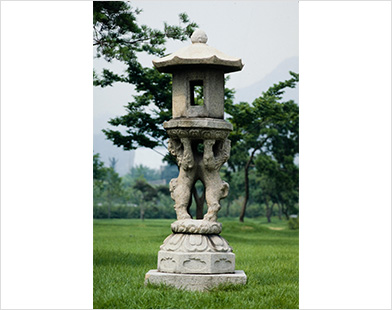 Twin Lion Stone Lantern of Jungheungsanseong Fortress, Gwangyang
Twin Lion Stone Lantern of Jungheungsanseong Fortress, Gwangyang
Stone lanterns are also called Gwangmyeongdeung (light lantern) as they symbolize the light of Buddha and they have traditionally been placed before important buildings such as Daeungjeon, or the main hall, or a pagoda. Generally, a stone lantern consists of a main body containing an area for the flame (fire chamber), with a three-tier support stone below and a roof stone above, and a head ornament at the top. This stone lantern is characterized by the engraving of twin lions instead of a central pillar above the bottom support stone surrounded by a lotus flower. The two lions are shown to be standing on their hindlegs and supporting what is above them, with their chests pressed together. The realistic and natural depiction of the lions is eye-catching. The octagonal fire chamber has four openings, and the roof stone is curved upward at the eight corners. This is a work dating from the Unified Silla Period, for which simplified and realistic depiction teengiques were employed. It is regarded as a masterpiece that demonstrates the exceptional sculpture teengiques and exquisite formative beauty, despite its relatively small size. Although it was originally found inside Jungheungsanseong Fortress, it was transferred to Gyeongbokgung Palace to prevent the Japanese from moving it without authorization, and it is presently on display at the Gwangju National Museum.
View Detail Bronze Artifacts from Daegok-ri, Hwasun
Bronze Artifacts from Daegok-ri, Hwasun
These artifacts were excavated from a tomb dating from the Bronze Age that was found on a hill next to the Yeongsangang River in Daegok-ri, Hwasun-gun. Among the Bronze Age artifacts uncovered, three slender bronze daggers, two bronze bells with eight heads, two bronze bells with twin heads, a bronze hand knife, a bronze ax and two bronze mirrors with fine lines were designated as national treasures. The slender bronze daggers have sharp edges on both sides, and one of them has a damaged blade. The protruding part of the center of the sword varies across the swords, which is a notable characteristic, and these were made in a later period compared with other bronze daggers unearthed in Korea. The bronze bells with eight heads are in the shape of an octagonal star, with a bell on each vertex. The bells contain bronze beads that make a sound when shaken. These bells are thought to have been used in shamanistic and religious ceremonies. A bracken fern design has been engraved on the face of the bell. The bronze bells with twin heads have bells on the two ends, with bronze beads inside that make a sound when shaken. It is presumed that these were also used in shamanistic and religious ceremonies.The bronze hand knife is a type of tool that is thought to have been used like the present-day sculpting blade. It has a flat blade, and the tip of the blade is partially broken. The bronze ax has a blade on one side and a groove on the opposite side through which a handle could be inserted. The side with the groove has the shoulder and the length is short compared to the width. The bronze mirrors with fine lines have rust on the mirror side, but they are in a fairly good condition. They feature geometric patterns on the back and there are two knobs for hanging the mirror. These bronze artifacts uncovered from Daegok-ri are diverse in terms of type and exhibit excellent production techniques, thus serving as important materials for those studying the Bronze Age on the Korean Peninsula and showing the advanced level of metalcraft techniques at the time.
View Detail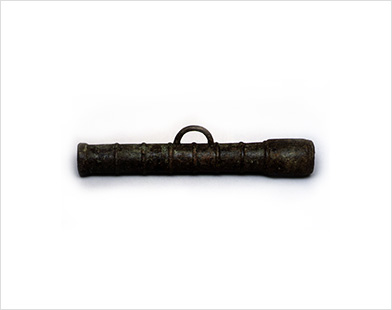 Hyeonja Chongtong Gun
Hyeonja Chongtong Gun
Yutongsikhwapo, referring to guns ignited and fired by hand, were classified into four types according to their size, amount of gun powder used, and firing range into cheonja, jija, hyeonja, and hwangja chongtong, based on Chinese characters. Of these, Hyeonja Chongtong Gun is the third largest.
This gun was uncovered from the bottom of the sea near Baekdo Island of Yeocheon-si, Jeollanam-do in 1992 along with a Jija Chongtong Gun and a Byeolseungja Chongtong Gun, both of which were found in a damaged state. Hyeonja Chongtong Gun is 75.8 cm in total length, while the muzzle diameter is 6.5 cm. The gun has an engraving of the maker, Yang Naeyodong, on the body. Since he was also the one who produced the Gajeongeulmyomyeong Cheonja Chongtong Gun (Treasure No. 647), it can be inferred that this gun was likely made around 1555 (the 10th year of the reign of King Myeongjong) during the Joseon Dynasty.
Among the seven Hyeonja Chongtong guns remaining today, this one is presumed to be the oldest, based on its production record, and it has been relatively well-preserved. For this reason, it is regarded as a valuable national defense heritage material and an important material in studying the development history of Korean artillery.
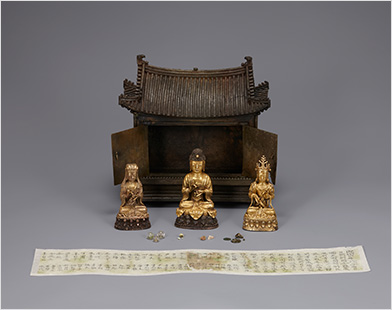 Bronze Shrine and Gilt-Bronze Seated Amitabha Triad
Bronze Shrine and Gilt-Bronze Seated Amitabha Triad
The Gilt-bronze Seated Amitabha Buddha Triad is characteristic of 15th century Buddha triads in terms of its formation consisting of Amitabha Buddha and Avalokitesvara and Ksitigarbha bodhisattvas and the headcloth worn by Ksitigarbha Bodhisattva. This is in line with the fact that the triad was made in 1468. On the other hand, the bronze shrine is not in its perfect state as it was arbitrarily repaired after being taken from the pagoda.
However, the fact that a Buddha statue fits well inside the shrine and that it is in a jeongak or palatial shape shows that it, too, was made in 1468 at the same time as the Buddha triad. It displays unique characteristics in the curves of the roof and the structure.
Through a written prayer discovered with the artifacts found in Maegok-dong, Suncheon, their exact production year was revealed. They are valuable works that well-demonstrate the characteristics of 15th century Buddha statues and shrines, and the shrine is especially valuable because of its never-been-seen-before features.
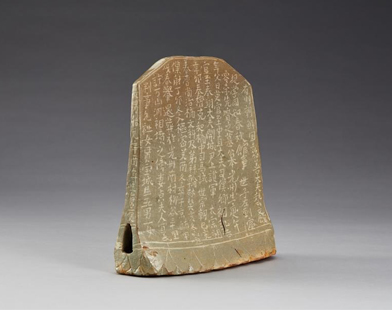 Buncheong Memorial Tablet of Yi Seon-je
Buncheong Memorial Tablet of Yi Seon-je
This epitaph tablet of the Joseon scholar Yi Seon-je (1390–1453) is inlaid with an inscription of 248 characters documenting his dates of birth and death, achievements, and details of his genealogy. The tablet was removed from the country in 1998. Its whereabouts were confirmed in 2014 through the efforts of the Overseas Korean Cultural Heritage Foundation. In 2017, Todoroki Kunie donated the tablet to the National Museum of Korea to honor the will of the owner, her late husband, who had been an afficionado of Korean art and hoped for friendly relations between Korea and Japan.
Yi Seon-je was a scholar-official who served the Joseon Dynasty at the Jiphyeonjeon (Hall of Worthies), participating in the compilation of The History of Goryeo (Goryeosa), The Annals of King Taejong (Taejong sillok), and The Divine Farmer’s Materia Medica (Sinnong boncho). He also served as governor of Gangwon-do Province and second minister at the Ministry of Taxation. When Gwangju was repromoted from Gwangsan-hyeon to Gwangju-mok, Yi named a pavilion Huigyeongnu in commemoration of the change. Yi is a major figure in the history of the Honam region (Jeolla-do Province), but even the dates of his birth and death had been unknown. In 1589 (the 22nd year of the reign of King Seonjo), Yi Seon-je’s fifth-generation descendant Yi Bal (1544–1589) and his family were purged during the Treason Case of 1589 (Gichuk oksa). At this time, Yi Seon-je was posthumously stripped of his title as a government official and his writings were lost. Though records related to Yi Seon-je were found in the annals of kings, it was only after the discovery of his epitaph tablet that the dates of his birth and death became certain.
The epitaph tablet is an important historical record that offers an accurate account of the life and descendants of Yi Seon-je.
It is of great significance since Gwangju is also home to an ancestral shrine for Yi Seonje (sobriquet: Pilmun), designated by the city as Folklore Heritage No. 7), and there is a street (Pilmun-ro) named in his honor.
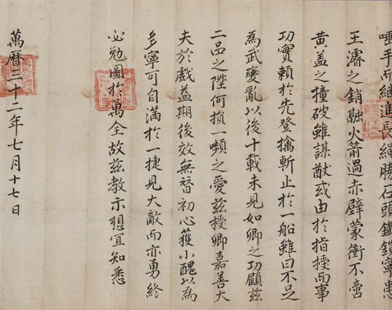 Royal Certificate Issued to Shin Yeoryang
Royal Certificate Issued to Shin Yeoryang
This was a gift made to the museum by the descendants of Shin Yeoryang of the Goryeong Shin clan.
This is a special royal certificate that was issued in 1604 to promote the naval officer Shin Yeoryang from Jeolchung janggun (with a rank of jeongsampum or senior third rank) to Gaseon daebu (jongipum or minor second rank) in recognition of his achievements in the Naval Battle of Dangpo (present-day Tongyeong, Gyeongsangnam-do Province) that was fought on July 17 of that year. The certificate provides a detailed record of the battle and of Shin’s achievements of in the vanguard.
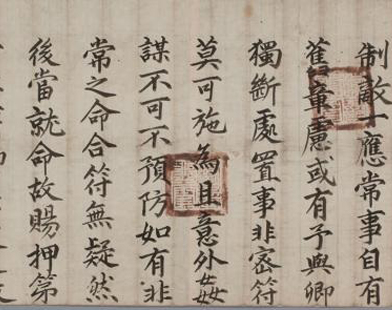 Royal Confidential Order Issued to Shin Yeoryang
Royal Confidential Order Issued to Shin Yeoryang
This was a gift made to the museum by the descendants of the Goryeong Shin clan.
This is a confidential royal order issued in 1605 to Shin Yeoryang, who had recently been appointed commander of the Right Naval Commander’s Headquarters. It was issued together with the “Seventeenth Tablet.” During the Joseon Dynasty, this type of order was issued to regional officers holding the right to exercise military commands, including governors (gwanchalsa), provincial army commanders (jeoldosa), and defense officers (bangeosa). There were forty-five tablets, each comprised of two pieces with the left half kept by the royal court and the right half by the commander. When a commander received an order together with the left half of a tablet, he would check to see if it matched his half. If they matched, he mobilized his military unit according to the orders received. This order is stamped with a seal reserved for orders issued to provincial commanders-in-chief.